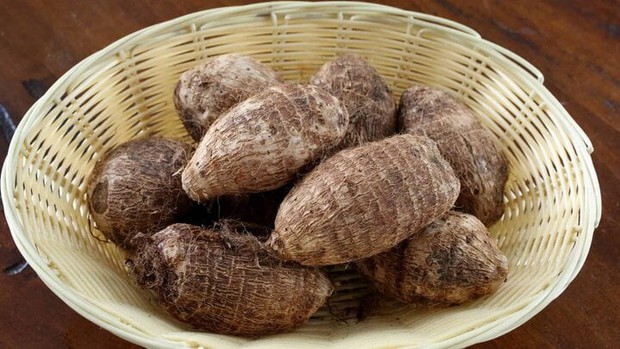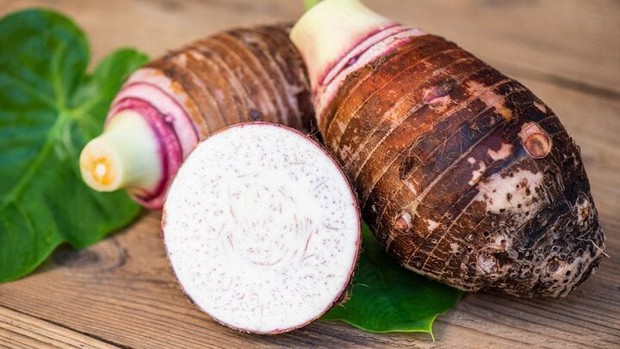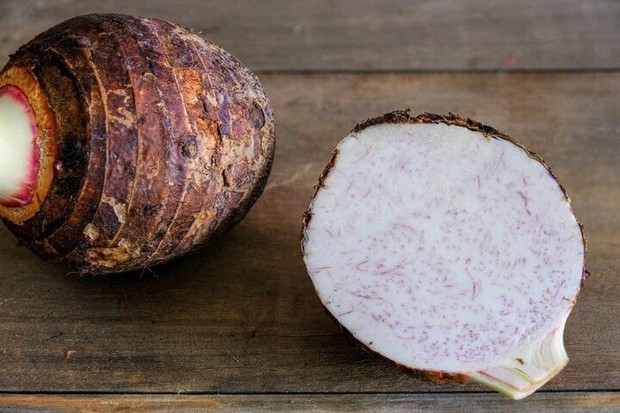Taro is a very healthy food and there are many ways to cook it, creating dishes that many people love. You can use it to fry, boil, stew, make soup, make desserts, or make cakes, all of which are delicious.
Should you choose big or small taro when buying?
If you are not careful when buying, you may choose poor quality taro that does not taste good. One of the questions many people ask is whether to choose big or small taro.

Choosing big or small taro is something that many people are confused about. (Photo: Maangchi)
The weight of the taro is one of the important criteria for choosing this food. Generally, when buying taro, we should choose the ones that are lightweight. According to the experience of farmers, light taro contains less water and has a high starch content, often crunchy and delicious. Heavy taro contains more water, the taste is usually bland, prone to rot, and not delicious.
Therefore, you don’t need to worry too much about whether to choose big or small taro, pay more attention to the weight of the taro.
Tips for choosing delicious taro

In order to buy delicious taro, you also need some tips. (Photo: Eater)
In addition to relying on weight, paying attention to the following factors can also help you choose the taro you desire.
Look at the appearance
When choosing taro, you should observe the external appearance of the taro. Since taro is dug up from the ground, they often have soil on the outside. If there is still soil sticking to the surface and the soil is relatively moist, it means that the taro was just dug up and is very fresh. If the surface of the taro is clean or the soil has dried out, it means that the taro has been stored for a long time and the flesh inside may be slightly withered. These taro often have a spongy texture, not ideal for consumption.
Look at the eyes of the taro
The hollow parts on the taro are the eyes of the taro. The taste and texture of taro are not directly related to the number of eyes. The more eyes there are, the softer, tastier, and more fragrant the taro will be.
On the other hand, taro with few or no eyes is usually less tasty.
Color and texture of the taro

When the taro is cut in half, the more purple veins you see, the better the taro is. (Photo: Storables)
Large taro is usually cut in half for sale. At this point, you can observe the cut surface of the taro. If you see a white color interspersed with many light purple veins, it means that the taro is of good quality. On the other hand, if the color inside is pale and the veins are sparse, the taro is usually not good and should not be purchased.
Furthermore, you can also lightly scrape the surface of the taro with a knife. If a little milky white liquid flows out at the scrape and when you lightly touch it with your hand it feels sticky and quickly dries, then this is a taro with high starch content and good quality.
The benefits of taro for health
Taro is one of the extremely nutritious potatoes with many health benefits:
Improves digestion
One of the biggest benefits of taro is stimulating digestive activity. Taro contains a large amount of fiber, which is very useful in supporting a healthy digestive system.
Taro also helps prevent problems such as bloating, indigestion, flatulence, constipation, and even diarrhea. A healthy digestive system can enhance overall health and reduce the risk of cancer.
Prevents cancer
Taro contains polyphenols, which are natural antioxidants and have many health benefits, including cancer prevention.
Quercetin is the main polyphenol found in taro, as well as an important component of apples, onions, and tea. Quercetin can inhibit the growth of cancer cells. It has antioxidant properties, supports apoptosis, and prevents the proliferation of cancer cells at different stages.
Moreover, taro also contains cryptoxanthin, which can prevent throat and lung cancer.
Regulates blood sugar
People who consume low glycemic index foods have a lower risk of heart disease and diabetes. Taro has a low glycemic index, which naturally helps diabetic patients effectively control their blood sugar levels.
Taro also supports blood sugar balance, reduces and controls lipids and triglycerides, thereby helping with weight loss and maintaining body mass index – BMI. It contains many nutrients such as protein, calcium, thiamine, phosphorus, riboflavin, niacin, and vitamin C to maintain good skin and overall health.
Prevents heart disease
Taro contains a good amount of starch and fiber. Doctors recommend consuming good fiber to prevent cardiovascular and coronary artery diseases. Fiber plays a vital role in reducing LDL – bad cholesterol. The resistant starch in taro reduces insulinemia reactions, improves whole-body insulin sensitivity, enhances food satisfaction, and reduces fat storage.
Boosts immune system
Taro plays an important role in boosting immunity, antioxidants, reducing blood sugar levels, regulating immunity, and antibacterial properties. Antioxidants neutralize free radicals in the body and prevent cell damage.
Supports weight loss
Taro has an average glycemic index and a high fiber content, which are necessary characteristics to support the weight loss process and control blood sugar levels in the body. In addition, taro provides essential minerals such as magnesium, calcium, potassium, phosphorus, iron, and zinc, and beneficial fiber for health. Fiber helps us feel full for longer, thus consuming fewer calories.



































